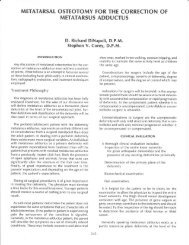A Case of Bilateral Severe Hallux Valgus Interphalangeus
A Case of Bilateral Severe Hallux Valgus Interphalangeus
A Case of Bilateral Severe Hallux Valgus Interphalangeus
Create successful ePaper yourself
Turn your PDF publications into a flip-book with our unique Google optimized e-Paper software.
C H A P T E R 4 0<br />
PEDIATRIC L-SHAPED DEFORMITY OF THE HALLUX:<br />
A <strong>Case</strong> <strong>of</strong> <strong>Bilateral</strong> <strong>Severe</strong> <strong>Hallux</strong> <strong>Valgus</strong> <strong>Interphalangeus</strong><br />
James H. Morgan, Jr., DPM<br />
INTRODUCTION<br />
<strong>Hallux</strong> valgus interphalangeus (HVI), unlike the more<br />
common deformity hallux valgus, has not received much<br />
attention in foot and ankle literature. <strong>Hallux</strong> valgus<br />
interphalangeus involves lateral deviation with valgus<br />
rotation <strong>of</strong> the distal phalanx in relation to the proximal<br />
phalanx. The deformity usually presents early in life and can<br />
rapidly progress during growth spurts. Possible etiologies<br />
<strong>of</strong> HVI reported by Barnett included obliquity <strong>of</strong> the<br />
articular surface <strong>of</strong> the proximal phalangeal head and an<br />
asymmetrical shape <strong>of</strong> the distal phalanx. 1 Sorto et al found<br />
a deviation <strong>of</strong> the articular surfaces <strong>of</strong> the interphalangeal<br />
joint present in the deformity. 2 Cansü cited lateralization <strong>of</strong><br />
the extensor hallucis longus (EHL) tendon insertion as an<br />
influencing factor. 3 Operative treatment options include the<br />
Akin osteotomy <strong>of</strong> the proximal phalanx or interphalangeal<br />
joint fusion. While mild cases <strong>of</strong> the deformity can be<br />
corrected after skeletal maturity with the Akin osteotomy,<br />
arthrodesis <strong>of</strong> the interphalangeal joint provides the greater<br />
amount <strong>of</strong> correction with more reliable long term results.<br />
CASE REPORT<br />
A 9-year-old male presented with HVI involving both feet.<br />
His symptoms included pain in the interphalangeal joint<br />
region with increase in activity and a painful callus that<br />
developed over the dorsomedial aspect <strong>of</strong> the head <strong>of</strong> the<br />
proximal phalanx. Padding and wider shoes failed to relieve<br />
his symptoms. There was no family history <strong>of</strong> great toe<br />
deformity, and the past medical history was unremarkable.<br />
Physical examination revealed a semi-rigid angular<br />
deformity <strong>of</strong> the hallux interphalangeal joint on both feet<br />
(Figures 1, 2). The distal phalanx was positioned lateral to<br />
the proximal phalanx with a valgus rotation <strong>of</strong> the distal<br />
phalanx, as well. A mild pes planovalgus deformity was also<br />
noted on both feet. Radiographs confirmed the diagnosis<br />
<strong>of</strong> HVI (Figures 3, 4).<br />
A hallux interphalangeal joint fusion was performed<br />
on both feet under general and local anesthesia. A double<br />
transverse semi-elliptical incision was made over the interphalangeal<br />
joint along with a midline linear incision over<br />
the proximal phalanx. The EHL tendon was noted to<br />
Figure 1. Clincal photograph <strong>of</strong> the right foot<br />
showing weight bearing attitude <strong>of</strong> the deformed toe.<br />
Figure 2. Clincal photograph <strong>of</strong> the left foot<br />
showing weight bearing attitude <strong>of</strong> the deformed toe.
238<br />
CHAPTER 40<br />
Figure 3. Preoperative weight bearing radiograph<br />
showing bony deformity <strong>of</strong> the right foot.<br />
Figure 4. Preoperative weight bearing radiograph<br />
showing bony deformity <strong>of</strong> the left foot.<br />
Figure 5. Postoperative radiograph, right foot.<br />
Figure 6. Postoperative radiograph, left foot.<br />
insert just lateral to the midline <strong>of</strong> the distal phalanx.<br />
The articular surface <strong>of</strong> the proximal phalanx was mildly<br />
laterally deviated. The distal phalanx articular surface<br />
lateral deviation was more pronounced. The head <strong>of</strong> the<br />
proximal phalanx was resected removing the entire<br />
articular surface perpendicular to the long axis <strong>of</strong> the<br />
proximal phalanx. Because <strong>of</strong> the open epiphyseal plate,<br />
the cartilage <strong>of</strong> the distal phalanx was resected to the<br />
subchondral plate with more resection medially. The<br />
deformity was reduced and fixated with percutaneous<br />
parallel 0.062-inch Kirschner wires (Figures 5, 6). The<br />
EHL tendon was repaired and the skin was closed.<br />
The patient was placed in bilateral post-surgical shoes<br />
for 6 weeks, and the wires were removed at 6 weeks. A<br />
return to full activity was allowed at 10 weeks. At the 12<br />
week follow-up, the patient was without symptoms. A<br />
solid arthrodesis <strong>of</strong> both hallucal interphalangeal joints was<br />
noted clinically and on radiographs (Figures 7-10).
CHAPTER 40 239<br />
Figure 7. Clinical postoperative photograph, right foot at 12 weeks.<br />
Figure 8. Clinical postoperative photograph, left foot at 12 weeks.<br />
Figure 9. Postoperative radiograph <strong>of</strong> the right<br />
foot at 12 weeks.<br />
Figure 10. Postoperative radiograph <strong>of</strong> the left foot<br />
at 12 weeks.<br />
CONCLUSION<br />
<strong>Hallux</strong> valgus interphalangeus is a complex deformity<br />
involving the articulation as well as the neighboring s<strong>of</strong>t<br />
tissue influences. The deformity can progress rather rapidly,<br />
so early surgical intervention is recommended. Because the<br />
deformity is usually rigid and severe, arthrodesis <strong>of</strong> the<br />
interphalangeal joint is recommended to provide reliable<br />
and long-lasting correction. The joint resection and fixation<br />
techniques described are recommended for the patient with<br />
open epiphyses.<br />
REFERENCES<br />
1. Barnett CH. <strong>Valgus</strong> deviation <strong>of</strong> the distal phalanx <strong>of</strong> the great toe.<br />
J Anat 1962;96:171.<br />
2. Sorto LA Jr, Balding MG, Weil LS, et al. <strong>Hallux</strong> abductus interphalangeus.<br />
Etiology, x-ray evaluation and treatment. J Am Podiatric<br />
Medical Assoc 1992;82:85.<br />
3. Cansu E. L-shaped big toe: a case <strong>of</strong> severe hallux valgus interphalangeus.<br />
J Am Podiatric Medical Assoc 2009;99:244-6.

















